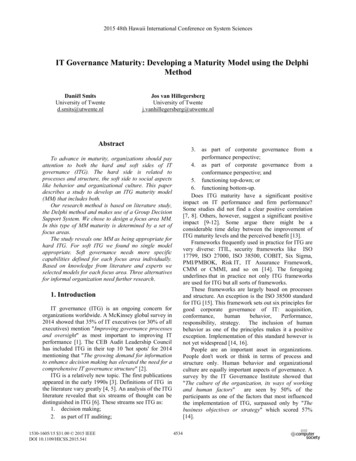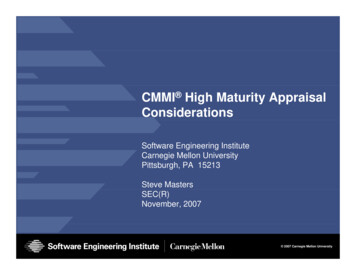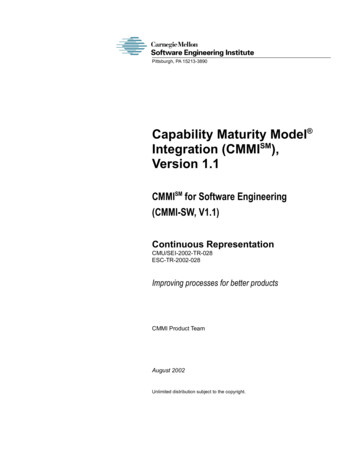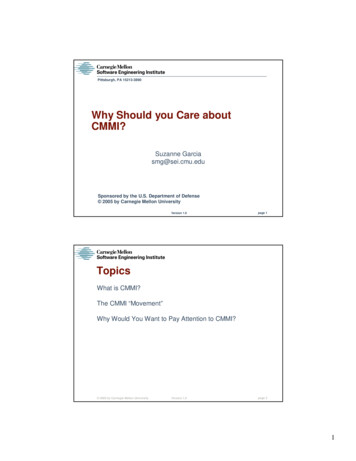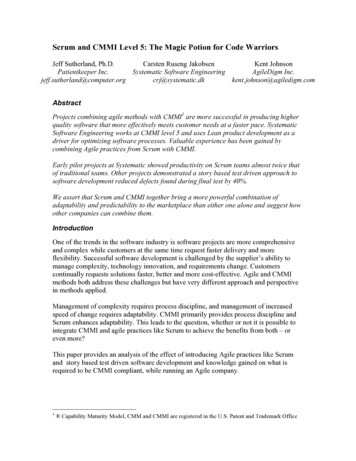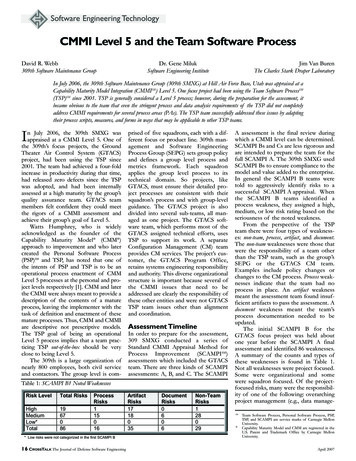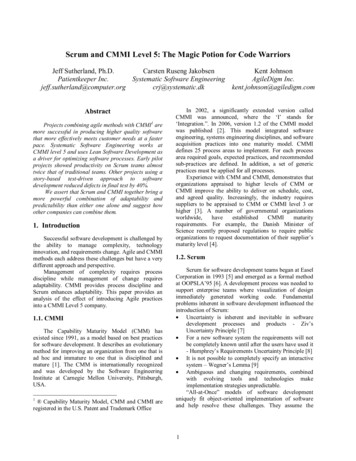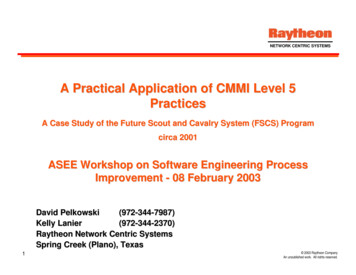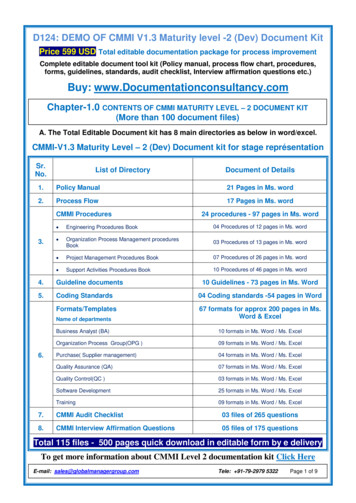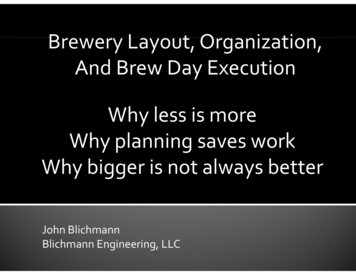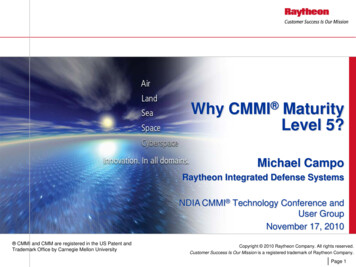
Transcription
Why CMMI MaturityLevel 5?Michael CampoRaytheon Integrated Defense SystemsNDIA CMMI Technology Conference andUser GroupNovember 17, 2010 CMMI and CMM are registered in the US Patent andTrademark Office by Carnegie Mellon UniversityCopyright 2010 Raytheon Company. All rights reserved.Customer Success Is Our Mission is a registered trademark of Raytheon Company.Page 1
Agenda OverviewWhy CMMI Maturity Level 5?Quality and Process Performance ObjectivesRaytheon Integrated Defense Systems Return on InvestmentSummaryPage 2
OverviewWhy Maturity Level 5?Where’s the benefit?It costs too much! Who’s paying for this?Maturity Level 3 is all we can afford!My customer says I only have to be Maturity Level 3!What is the impact of Maturity Level 5 on business goals?This presentation will summarize: Why CMMI Maturity Level 5 offers value to a business Benefits Raytheon Integrated Defense Systems has realizedfrom deploying Maturity Level 5 processesPage 3
High Maturity ControversyFounding Fathers Debate High MaturitySWCMM GanslerMemoCMMI Page 4
The Race is On!Level 5RFP mustbe . Level 5RFP mustbe . Level 5Level 5RFP mustbe . Level 5Level 5Level 5RFP mustbe . Level 5Level 5RFP mustbe . Level 5Page 5
Fallout!“We have five maturity levels.We know three of them work.”Mark SchaefferOffice of the Under Secretary of DefenseNDIA CMMI Technology Conference, 2007Page 6
Response!And now 11FrequentlyMisinterpretedML 4-5 Practices!CMMI Criteria for Audits ofHigh Maturity AppraisalsAnnounced!SCAMPISM High Maturity LeadAppraiser CertificationAnnounced!Next up: High MaturityMisconceptions - CommonMisinterpretations of CMMI Maturity Levels 4 and 5!Informative Material isImportant to CMMI Model Interpretation andImplementationIf You’re Living the HighLife You’re Living theInformative Material!BBC CMMI is registered in the US Patent and Trademark Office by Carnegie Mellon UniversitySM SCAMPI is a service mark of Carnegie Mellon UniversityPage 7
Why CMMI Maturity Level 5? CMMI was created to support business improvement– CMMI is a means to an end, not an end unto itself– As a model containing best practices, CMMI is a business strategy tool to helpachieve business objectives Business objectives often differ based on an organization’s level of maturity– ML 2 and ML3 are about avoiding disasters and gaining control ML 2 organization objectives: avoid disasters due to unrealistic plans, lack of requirementsmanagement, poor CM, management without progress measures, etc. Example: begin measuring individual project productivityML 3 organization objectives: increased consistency of performance, commonorganizational process tailored by all projects, proactive project management Example: collect productivity on all projects using a tailored common process– ML 4 and ML 5 are about managing against quality and process performanceobjectives to improve performance capability ML 4 and ML 5 organization objective: quantitatively manage ability to perform againstquality and process performance objectives that align with business objectives, take actionaccordingly, and perform causal analysis to improve performance Example: understand variation in productivity, quantify ability to perform against productivityobjective, target corrective action to improve productivity at project and organizational levelsPage 8
CMMI Maturity Level 3 vs. Level 5Maturity Level 3Maturity Level 5PMC SG1: Actualperformance andprogress of the projectare monitored againstthe project plan.OPP SP 1.3 Establishand maintain quantitativeobjectives for quality andprocess performance forthe organization.IPM SP 1.5: Managethe project using theproject plan, the otherplans that affect theproject, and theproject’s definedprocess.QPM SG1: The project isquantitatively managedusing quality and processperformance objectives.OPF SG1: Identifyimprovements to theorganization’s processand process assets.CMMI ROI ScaleOID SG1: Process andtechnologyimprovements, whichcontribute to meetingquality and processperformance objectives,are selected.Page 9
Quality and Process PerformanceObjectivesThe engine that drivesproject performanceThe engine that drivesbusiness performanceCPIProductivityDefect DensitySPIDefect ContainmentRequirements VolatilityThe engine that drives highmaturityPage 10
IDS Quality & Process PerformanceObjectivesRaytheon GoalsBe regarded as a customerfocused company.Grow revenue faster thanmarket. Build on goodperformance in improving cashflow. Execute well and withpredictability.Retain and attract world-classtalent while providing superioropportunities for employeedevelopment. Treat allemployees with respect.Leverage our diversity efforts asa competitive advantage,continuing Raytheon’s leadershipin diversity.Improve ROIC for RaytheonCompany. Take R6σ to thenext level, further engagingcustomer and partners. Delivergreater value and predictabilitythrough IPDS, EVMS, andCMMI .Raytheon Integrated Defense Systems (IDS) GoalsRaytheon IDS Engineering Quality and Process Performance ObjectivesCostScheduleQualityPeopleCPI XProductivity X% BidDefect Containment X%Requirements Volatility X%SPI XProductivity X% BidOn-time DeliverablesAverage X%Defect Containment X%Defect Density XRequirements Volatility X%Average X Hours Trainingper EmployeePage 11
Raytheon IDSReturn on Investmentfrom ImplementingCMMI Maturity Level 5Page 12
Assumptions - 1 Data used in this study compared IDS 2005 performance 2005 - 2008– IDS achieved ML 3 for SE/SW in 2003, ML 4 for SE/SW & ML 3 for HW in 2005, and ML 5for SE/SW/HW in 2008 Actuals and Estimates– In most cases, actual data was used in this study. If actuals were not available,conservative estimates were used with rationale Projecting future return from CAR/OID projects is generally estimatedDefining “Investment”– The cost of all activities to incorporate maturity level 4 & 5 practices into ourbusiness processes and be appraised Appraisal costs, development and deployment of updated processes andenablers (e.g., process performance models), and training Calculating “Savings”– Apply baseline rates (e.g., 2005 productivity) against 2008 size (e.g., lines ofcode) to calculate “projected cost at baseline rates” Projected cost at baseline rates “2005 productivity” * “2008 size” * “2008 labor rate”– Compare “projected cost at baseline rates” to 2008 actuals Savings “projected cost at baseline rates” - 2008 actualsPage 13
CAR/OID Sample included 19 CAR/OID process improvement projects– 14 CAR, 5 OIDROI on CAR/OID projectsROI on OID projectsROI on CAR projectsTotal ROI38.4 : 157.1 : 125.8 : 1Highest ROI183.3 : 1183.3 : 185.5 : 1Lowest ROI1.9 : 110.7 : 11.9 : 1Median ROI14.3 : 150.8 : 19.6 : 1Number ofdata points19514 The large ROI on CAR/OID projects is not surprising– CAR/OID projects focus on IDS Engineering goals– 7 Defect Containment,10 Productivity, 1 CPI, 1 Measurement Team Training OID ROI is much higher than CAR projects Benefits seen across programs provides more ROIApplying CAR project improvements wider across theenterprise would result in more savingsPage 14
Systems Engineering Requirements Volatility– 56.1% improvementRequirements Development Productivity– 14.3 % improvementCPI– 4% improvement– CPI variance reduction of 63%Page 15
Software Engineering DCTI Productivity– 65% improvementDefect Containment (SW Design through SW Maintenance)– 11.6% improvementPage 16
Hardware Engineering Mechanical Engineering Productivity– 25 % improvementElectrical Design Productivity– Analog: 33% improvement– Digital: 56% improvementDefect Density for Drawing Checking– 65% improvementPage 17
On Time 00699.66%200799.89%200899.82%2009100.00%Through MayOn Time Deliverables increase 4.9% since 2003.On Time Deliverables 99% since 2006.Page 18
Return on InvestmentQuantified ROI from IDS CMMI Maturity Level 5 activity: 24 : 1 Comparison with industry – from “PerformanceResults of CMMI -Based Process Improvement”,August 2006, CMU/SEI-2006-TR-004 Median ROILowest ROIRaytheon IDSHighest ROI4:11.7 : 124 : 127.7 : 1IDS results are a direct consequence of meaningful process improvementaligned with the business and engineering objectives Focus on major savings items: productivity, defect containment,CPI/SPI produces real results – the essence of Level 5!Page 19
Summary What an organization gets out of process deployment and CMMI appraisals is a reflection of what the organization puts into it– Organizations that focus on a maturity level number and “minimal compliance”are unlikely to derive any benefits High maturity, with its focus on quality and process performanceobjectives, puts organizations and projects in a position to succeed– OPP applies statistics to management Establish quality and process performance objectivesProcess performance models that illuminate potential problems in achieving objectivesand address real project issues are invaluable to the organizationProcess performance baselines identify the ability of the organization and its programsto perform in relation to their objectives– QPM and CAR push organizational objectives into projects’ daily activities Makes the objectives real to projects, and not just rhetoricHelps projects more fully understand their role in business successHaving organizational/project goals in project metrics charts focuses project reactionwhen objectives are not being– OID prioritizes process improvements based on their relationship to objectivesPage 20
Summary (continued)All Maturity Levels offer benefits Maturity Levels 2 and 3 help prevent disasters and gain control– Are not focused on quality and process performance objectives as a the driverof process improvement activity– Set a low ceiling on benefits of CMMI - based process improvement Maturity Levels 4 and 5 manage ability to perform against quality andprocess performance objectives that align with business objectives, andtake action accordinglyA high maturity organization where all individualsrecognize their role and responsibility for businesssuccess is an organization that is more likely to achievesuccess.Page 21
QuestionsPage 22
Contact Information For future questions the presenter contact information is:Michael CampoEmail: Michael J Campo@raytheon.comPhone number: 978.858.5939Raytheon Integrated Defense SystemsTewksbury, MA 01876Page 23
Presenter Biography Michael Campo is a Principal Engineering Fellow atRaytheon Company, with 32 years experience thatincludes roles as a software developer,software/system integrator, manager, softwareproject manager, and process group leader. Asprocess group leader for Raytheon IntegratedDefense Systems, Mike developed and deployedprocesses that led to achievement of CMMIMaturity Level 3 in 2003, Maturity Level 4 in 2005,and Maturity Level 5 in 2008.Mike’s present position is IDS Process TechnicalDirector. He is a certified CMMI Instructor. Mike isa member of the CMMI V1.3 Core Model Team, theCMMI V1.3 Training Team, the CMMI ConfigurationControl Board, and the NDIA CMMI Working Group.Page 24
Why CMMI Maturity Level 5? CMMI was created to support business improvement – CMMI is a means to an end, not an end unto itself – As a model containing best practices, CMMI is a business strategy tool to help achieve business objectives Business objectives of
